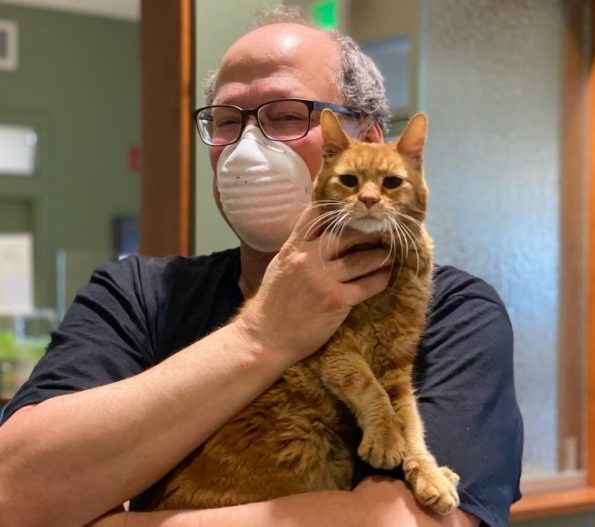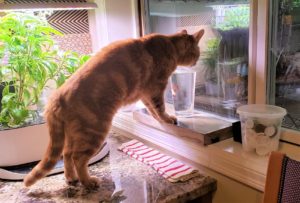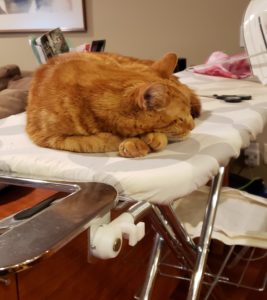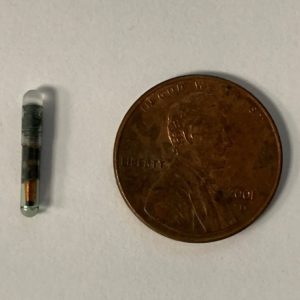
Our January Pet of the Month celebrates Topaz, an orange tabby cat who was recently reunited with his family because he was microchipped. Whenever we hear about lost pets being found, it always makes us feel good. In Topaz’ case, it was a remarkable and joyous occasion because he had disappeared from his home in 2014.
We don’t know how Topaz ended up missing, but late last fall his family received a call from an animal shelter in Wenatchee. They had scanned him for a microchip and they took the time to track down the listed owner. His family was overjoyed! Topaz is now safely back home and has settled in well. You can see from several of the following pictures, that he has made himself right at home and is getting spoiled to boot.
Many pet owners are aware that microchipping is an option for your pet – dog, cat, bird, bunny etc. Most shelters and many breeders will now implant microchips before you adopt your pet. However, microchips are only successful if you keep your contact information up to date and the microchip number is registered with a national database. While collars and tags are helpful, they can be removed, fall off or become difficult to read. Other forms of identification like a tattoo, do not have a central database so someone else won’t be able to link the tattoo to you specifically.
What is a microchip? There are a variety of microchip brands which are all very similar. The chip itself is a small rice-sized glass enclosed transponder that when scanned, sends a radio signal back to the scanner. In our domestic pets, the microchip is implanted under the skin over the nape of the neck. The scanner reads a sequence of numbers and/or letters that are unique to each microchip, and if the microchip has been registered, then the number can be linked with a specific animal and pet owner.
How can a microchip be helpful? Beyond being a method of permanent identification, here are some other ways a pet microchip can be beneficial.
- Recording your pet’s body temperature
The newest HomeAgain microchip, which Hawthorne Hills Veterinary Hospital is now using, also reads a pet’s body temperature. This is a really nice feature for pet’s who are not thrilled when we use a thermometer. - Activating a controlled food feeder
This can be useful when you have multiple pets and want to ensure that they aren’t eating the other pet’s food. Particularly helpful if you have pets who are on special foods. - Pet doors
If you have a pet door into your house, a microchip reader can limit the possibility that another pet or wildlife (raccoon) can get into your house uninvited. - Moving
If you are planning to move, having your pet microchipped and updating your contact information can be important. Some pets have been known to escape and travel back to their original home, sometimes miles away. - Travelling on vacation with your pet
If you travel to a vacation house with your pet, travel to visit relatives or decide to travel around the country; a microchip can be invaluable. Pets sometimes escape the car at a rest stop, slip their collar, or break out of their carrier in the airport. - Pet Travel Overseas or to Hawaii
If your pet will be travelling, especially to Hawaii or overseas, they will need to be microchipped before departure and the microchip number recorded on the Health Certificate.
If your pet isn’t currently microchipped, we can implant a microchip at the time of their next visit. Please call 206-528-1980 to schedule an appointment.
If your pet is already microchipped, please take the time to ensure that your contact information is up to date on one of the national databases. Some microchips may have a number ‘zero’ and others may have the letter ‘O’ – you’ll need to be sure you enter numbers/letters correctly. If you know which brand microchip your pet has, and your pet’s microchip number, you can look them up by logging into your account.
If you aren’t sure if your pet is registered, but you know their microchip number, you can check your pet’s microchip registration by going to: AAHA Universal Pet Microchip Lookup https://petmicrochiplookup.org/

 6512 12th Ave NE
6512 12th Ave NE







